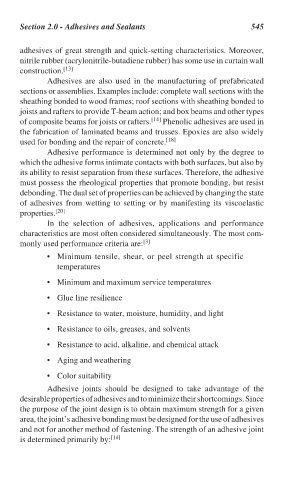Page 575 - Handbook of Thermal Analysis of Construction Materials
P. 575
Section 2.0 - Adhesives and Sealants 545
adhesives of great strength and quick-setting characteristics. Moreover,
nitrile rubber (acrylonitrile-butadiene rubber) has some use in curtain wall
construction. [13]
Adhesives are also used in the manufacturing of prefabricated
sections or assemblies. Examples include: complete wall sections with the
sheathing bonded to wood frames; roof sections with sheathing bonded to
joists and rafters to provide T-beam action; and box beams and other types
of composite beams for joists or rafters. [14] Phenolic adhesives are used in
the fabrication of laminated beams and trusses. Epoxies are also widely
used for bonding and the repair of concrete. [18]
Adhesive performance is determined not only by the degree to
which the adhesive forms intimate contacts with both surfaces, but also by
its ability to resist separation from these surfaces. Therefore, the adhesive
must possess the rheological properties that promote bonding, but resist
debonding. The dual set of properties can be achieved by changing the state
of adhesives from wetting to setting or by manifesting its viscoelastic
properties. [20]
In the selection of adhesives, applications and performance
characteristics are most often considered simultaneously. The most com-
monly used performance criteria are: [3]
• Minimum tensile, shear, or peel strength at specific
temperatures
• Minimum and maximum service temperatures
• Glue line resilience
• Resistance to water, moisture, humidity, and light
• Resistance to oils, greases, and solvents
• Resistance to acid, alkaline, and chemical attack
• Aging and weathering
• Color suitability
Adhesive joints should be designed to take advantage of the
desirable properties of adhesives and to minimize their shortcomings. Since
the purpose of the joint design is to obtain maximum strength for a given
area, the joint’s adhesive bonding must be designed for the use of adhesives
and not for another method of fastening. The strength of an adhesive joint
is determined primarily by: [14]

